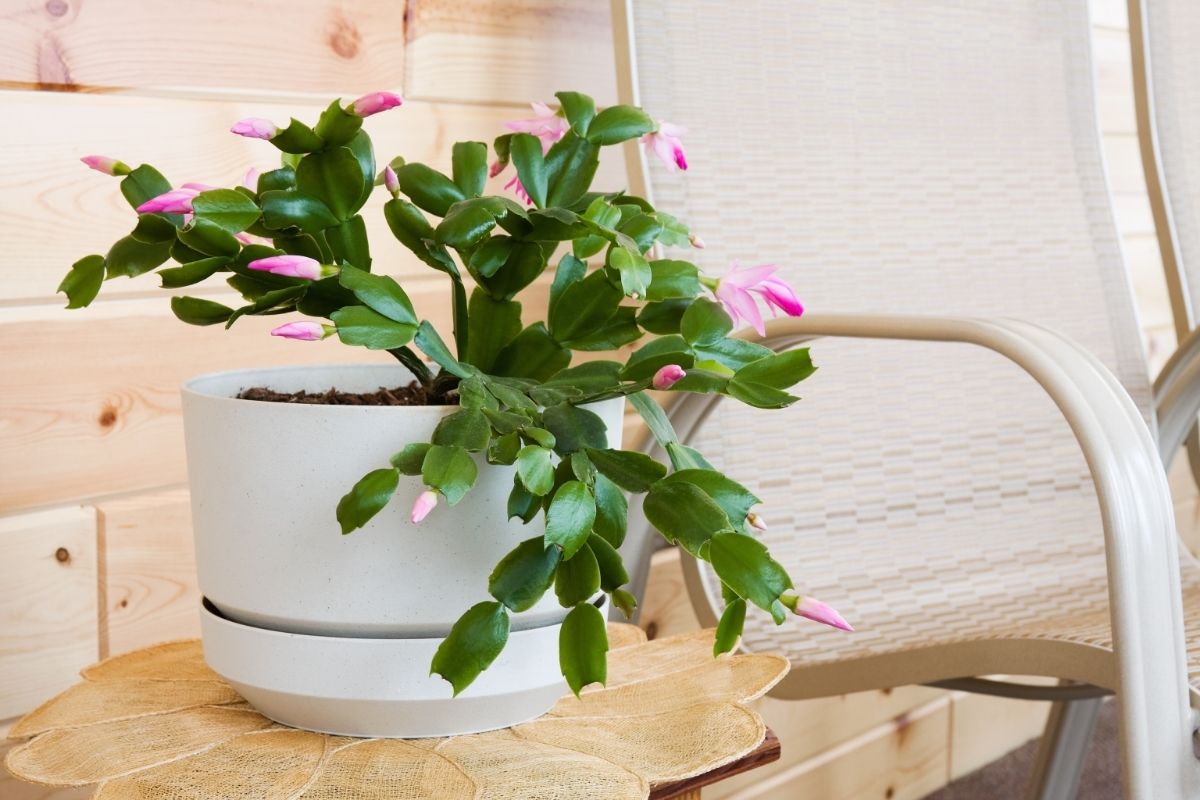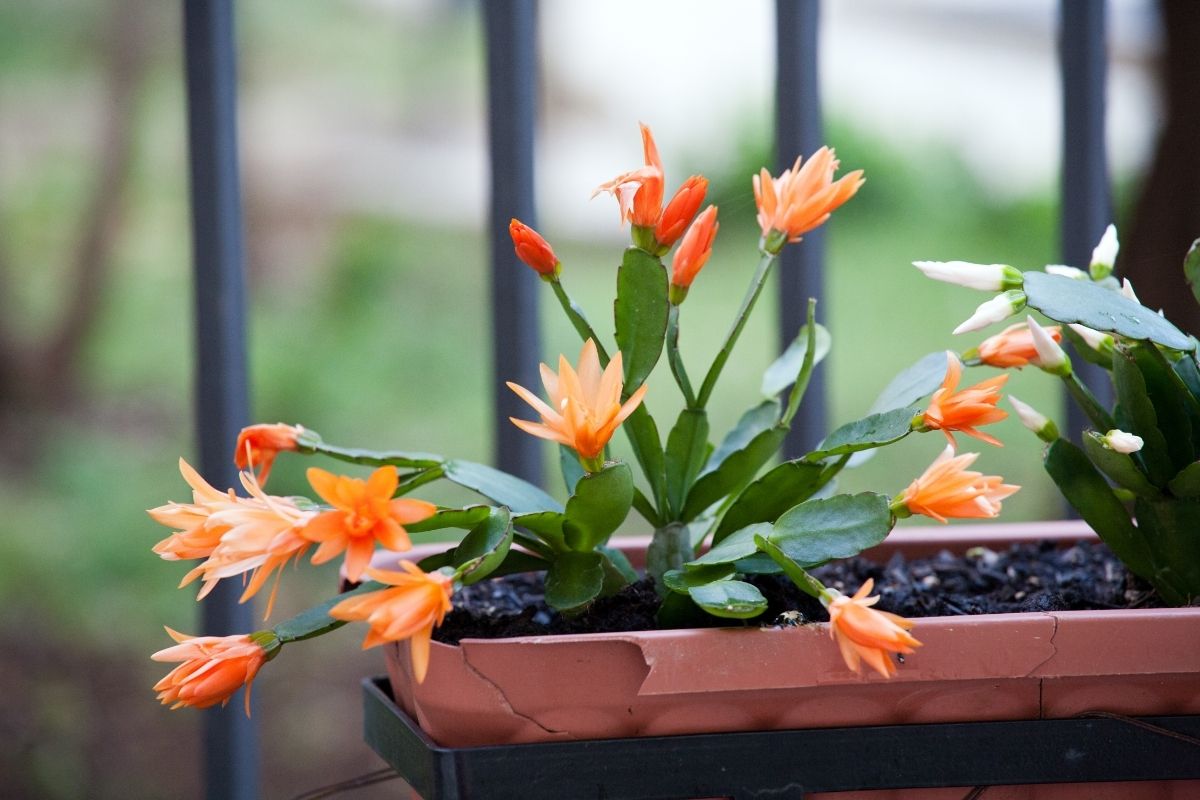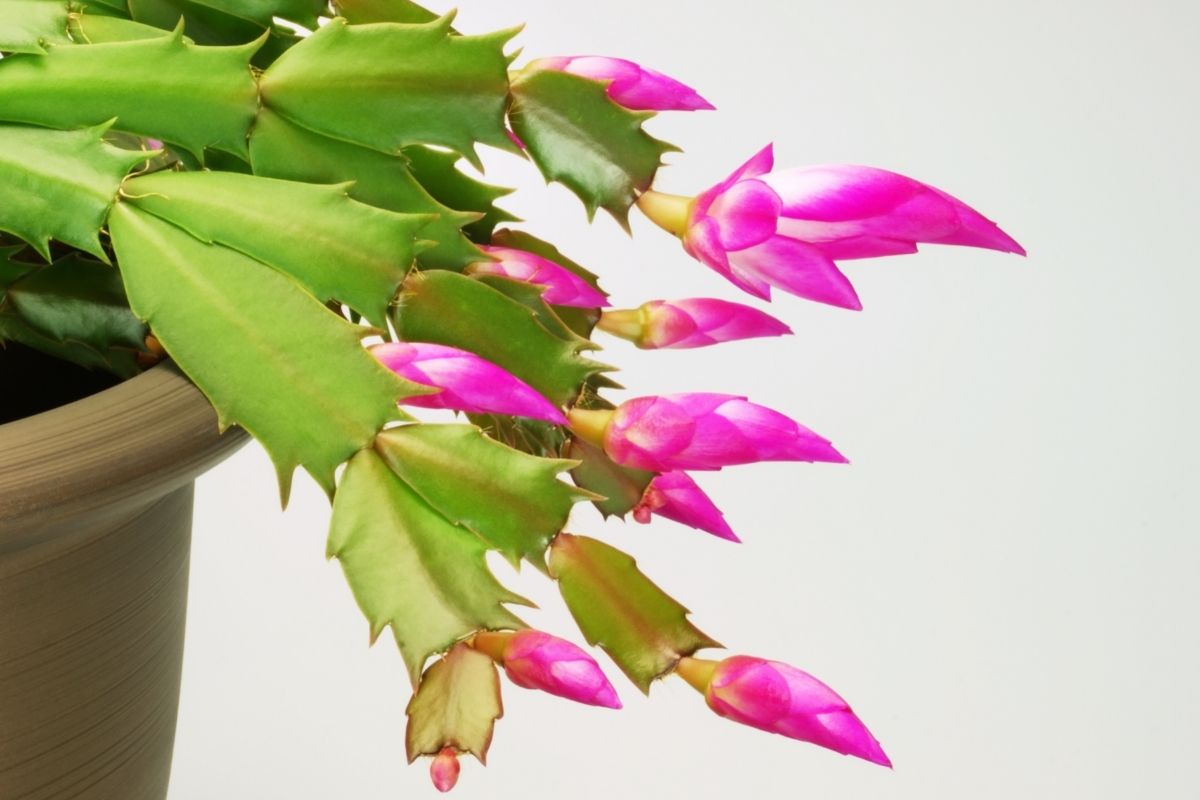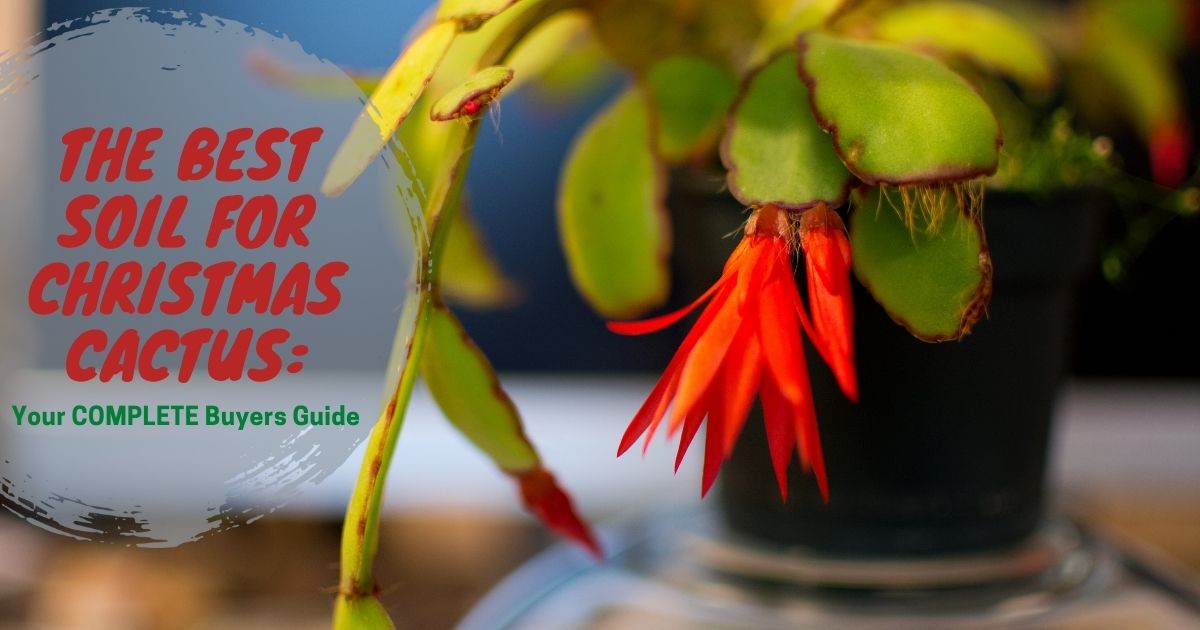What is a Christmas Cactus?
The Christmas cactus is a popular houseplant because it’s stunning. You can plant them on the best soil for Christmas cactus. They produce gorgeous, tubular flowers in pink or lilac colors when they bloom. They’re a great plant because of their lovely blossoms, long bloom time, and low maintenance requirements.

How to Grow a Christmas Cactus
Which is the best way to grow Christmas cactus? Cutting a small Y-shaped segment from the stem tips is easy to propagate the Christmas cactus. However, make sure the cutting comes from solely healthy plant foliage. Plant the piece in slightly sandy soil about a fourth of its length deep.
Place the cutting in a well-lit spot away from direct sunlight and moisten it evenly. Cut back shoots from the tips, cutting at the second joint of each tip, to root cuttings for new plants. Allow it to be callous for a few days.
Within a few weeks, the cutting should show signs of growth, at which point you can transfer the plant to another container with a looser potting soil mix of compost, loam, and sand if you desire. A soil pH balance of 5.5 to 6.2 is ideal for the plant.
Repotting Christmas Cactus – What you Should Know
You should repot Christmas cactus when the plant stops blooming, and the flowers wither, usually in late winter or early spring. However, this plant is content to get relatively compact – so if you don’t see roots crawling out the pot or drainage holes, you can put off repotting a Christmas cactus. Below are top tips for repotting a Christmas cactus:
Use a Lightweight and Well-Draining Potting Mix
Make your succulent repotting mix with four parts compost, one part bark, one part horticultural sand, one part fine grit, and one part pumice.
Select a Container That is Larger Than The Current Nursery Pot
To avoid root rot, make sure the pot has a drainage hole.
Carefully Remove The Christmas Cactus From The Pot
Remove the plant and its complete root ball from the container using your hand at the base of the Christmas cactus, under the foliage. Give the potting mix a slight squeeze to remove any old soil around the roots.
Set The Christmas Cactus in its New Pot To Be Comfortable
Fill the larger pot halfway with the new potting mix and make a well in the middle. Backfill the new area with more potting mix until there’s approximately 1 inch (2.54 centimeters) of space between the top of the soil and the rim of the pot, ensuring that you cover all of the roots. Pat it down to eliminate any air pockets and fill in gaps.
Moderately Water The Christmas Cactus
Water the Christmas cactus gently over the sink until water drains from the drainage hole, then lay it aside in a cool place for a few days to adapt before returning to its regular care regimen.
What Soil Do You require For a Christmas Cactus?
A Christmas cactus thrives on soil rich in organic materials but drains well. Four parts well-rotted compost, one part bark, one part horticulture sand, one part fine grit, and one part pumice are ideal. Avoid using peat, as it is not an environmentally beneficial option.
How do You Separate a Christmas Cactus?
To split or divide a Christmas cactus and repot it, remove it from its container, then carefully separate parts of the roots from the mother plant with a sharp knife. You can plant these new portions in other pots, and the original plant repot back into its original container – where it will have more space – or into a new, larger pot.
How Often do you Water a Christmas Cactus?
Unlike many other cactus species, the Christmas cactus (Schlumbergera bridgesii) is a tropical cactus that does not grow in a hot, dry climate. It is primarily grown as a houseplant in the United States, but you may also grow it outdoors in USDA hardiness zones ten or warmer.
The Christmas cactus blooms around the holidays, as its name suggests. It needs knowledge of its demands, such as how often to water it, keep it healthy and flower appropriately.
- When and how often do you water a Christmas Cactus? When the top inch of soil on your Christmas cactus is dry, water it. Always keep in mind the weather and the time of year. You may need to water your cactus every two to three days outside in a hot, dry region, mainly if it stays in the sun. If you keep the cactus indoors in a chilly or humid environment, you may only need to water it once a week. To encourage blossoming, water it less in the fall and winter.
- Avoid over-watering and under-watering. Overwatering is a problem for Christmas cactus as well as other cactus species. Overwatering can induce fungal rot illnesses like white rot and leaf drop. The white patches on the leaves of white rot disease are immediately identifiable. Because the Christmas cactus is a tropical cactus rather than a desert cactus, it cannot withstand as much under-watering as other cactus species. When you don’t give a Christmas cactus enough water, it wilts and loses its flower buds. Unlike a desert cactus, a Christmas cactus cannot endure arid soil. Avoid overhead watering to avoid fungus problems.
- How to preserve humidity. In a humid atmosphere, the Christmas cactus thrives. This is especially crucial for gardeners who live in a dry region or have a dry indoor climate. Placing a water dish near your plant is the most straightforward approach to humidity. The water evaporating into the atmosphere provides moisture. Another option is to fill a dish with gravel and water before placing the plant inside. You can also add humidity by misting your cactus with a spray bottle.
- Other requirements for growth. The Christmas cactus prefers indirect bright light. Keep them out of direct sunlight from the south or west if you’re growing them indoors. Do not place Christmas cactus in cold drafts and keep away from hot air sources such as heating vents or fireplaces. Fertilize as soon as tender growth develops in the spring. Use a liquid houseplant fertilizer every two to three weeks until the first blooms show, up to a month ahead of time.

At a Glance: The Soil for Christmas Cactus
- Soil Sunrise: Best Hand-Blended Soil.
- Josh’s Frogs Holiday/Christmas Cactus Soil: Best Special Mixture.
- Hoffman: Best Mixed Potting Soil.
Our Top Pick
Soil Sunrise is our best pick. It is the best hand-blended potting soil for Christmas Cactus.
The Best Soil for Christmas Cacti Shopping Guide
Specially Formulated Mixes
Succulents have an evolving clever DNA that allows them to adapt to dry areas with porous, sandy soil. If you don’t recreate that succulent-specific habitat when you bring your succulent home, your beloved plant will struggle to thrive. Over-watering is one of the primary causes of succulent death.
Soil Composition
Crumbley or gritty soil that is well-aerated and drains effectively is the best soil for Christmas cactus. It should also include a variety of particle sizes, around 14 inches (36 centimeters), to enhance airflow and manage moisture content.
Succulent Soil
One of the main reasons for adopting pre-made soil is that the pH balance in our yards may not be ideal. You can prepare succulent soil with a certain pH balance in mind, ensuring that the soil does not become too acidic. Succulents thrive in slightly acidic soils with pH levels of about 5.5 or 6.
Organic vs. Inorganic Matter
Peat moss, finely crushed bark, and finely ground coconut fibers are examples of organic debris that help water infiltrate the soil quickly. One of the issues with organic matter that isn’t finely powdered and arrives in large chunks is that it can retain a lot of water.
You can find peat moss in soil mixes such as Hoffman, Espoma, Miracle-Gro, and Perfect Plants. These products may suit sturdy succulents, but they may cause problems with water retention in more delicate succulents.
The inorganic matter: Succulents thrive on inorganic stuff, such as the Fat Plants San Diego 1-gallon (3.785 liters) Succulent Soil Mix. Perlite or sand, for example, are grittier inorganic components that maintain the soil well-drained.
Ingredients in a Healthy Soil
Other important succulent soil components, including Japanese Akadama, pumice, pine bark, and Haydite, help with drainage, nutrient retention, and air circulation.
- Haydite, also known as expanding shale, collects surplus water before slowly releasing it back to the roots.
- Hard Akadama is a volcanic waste that you can only find in Japan. It holds nutrients and water well, but it also breaks down to allow roots to grow and prevent water from pooling around the roots’ bottoms.
- Pumice is a volcanic waste that is excellent at keeping water and nutrients in the appropriate proportions.
- New Zealand Pine Bark also aids in the retention of the proper quantity of water and nutrients required by succulents and cacti.
- Perlite is a white amorphous volcanic glass that is amorphous. It’s a fantastic element for succulent soil since it helps succulent plants store nutrients and moisture while draining excess water.
- Vermiculite is similar to perlite, except it has better water retention. Perlite and vermiculite are both pH neutral. Thus they won’t change the pH of the soil mix.
Our Top Picks for The Best Christmas Cacti Potting Mixes
Soil Sunrise: Best Hand-Blended Soil
Amazon’s Choice Award in Garden Soil by Soil Sunrise
Brand: Soil Sunrise
Dimensions: 12.01 x 11.22 x 4.21 inches (30.5x 28.4 x 10.6 centimeters)
Weight: 2.05 pounds (0.93 kilograms)
About This Item
- It is a hand Blended Christmas Cactus Soil. Hand blended soil for planting, repotting, and nurturing Zygtocactus Plants. Master soil blenders are adept at producing plant-specific blends to enhance growth and progress. They hand-blend each batch of soil using all-natural components.
- It contains the following ingredients: Peat moss, perlite, fir bark, pumice, worm castings, and lime.
- The ideal mixture for plant success – Christmas Cactus can stay alive in various potting soils. Still, if you want your plants to thrive, you’ll need to offer a fast-draining, high-organic-matter environment that promotes development and progress. Perlite and pumice enable quick water evaporation, while orchid bark and worm castings add an organic element to promote excellent nutrition.
- Great for repotting, planting, and growing. This soil blend is ideal for repotting, planting, and growing Christmas cacti, or zygocactus. A rich, fast-draining potting soil can benefit these plants at all stages of their development, from sprouting to blooming.
Josh’s Frogs Holiday/Christmas Cactus Soil: Best Special Mixture
Brand: Josh’s Frogs
Dimensions: 8.82 x 5.55 x 2.6 inches ( 22.4 x14.09 x 6.6 centimeters)
Weight: 6.7 ounces (3.04 kilograms)
About This Item
- It contains a particular blend for potting soil, making it the best potting soil for Christmas cactus.
- The soil is quick draining which prevents root rot by allowing water to drain quickly.
- It gives room for airflow around the roots, which is critical for the health of the Holiday/Christmas cactus.
- Christmas cactus is an epiphyte in nature, making it easy to provide structure for the roots to grab.
- Sprig and Stone have more soils. Bromeliads, cacti, carnivorous plants, gesneriads, Rhipsalis, African violets, succulents, orchids, and tropical plants can benefit our soils.
Hoffman: Best Mixed Potting Soil
Amazon’s Choice Award in Garden Soil by Hoffman
Brand: Hoffman
Dimensions: 19 x 4 x 13 inches ( 48.2 x 10.1 x 33.02 centimeters)
Weight: 7.65 pounds (3.47 kilograms)
About This Item
- You can use any succulent. This is an excellent soil mix for succulent plants like cactus, and it also has a reasonable price. This soil is suitable for all cactus species, including those from the jungle and the desert.
- Lightweight and airy. This dirt provides the proper drainage various succulent plants require. This soil has a balanced pH, and you may use it immediately out of the package. This soil does not need a mix with any other items because it is fully prepared.
- Beginner gardeners will like the friendliness of this plant. There’s no need to worry if you’re a novice gardener. This item comes with comprehensive instructions. As soon as you read the instructions, you’ll know exactly how to use them.
- Ingredients are organic. Canadian Sphagnum Peat Moss, Reed Sedge Peat, Perlite, Sand, and Limestone are among the ingredients.
- Pearson’s Garden Gloves are inside the package. You will receive one pair of rubber garden gloves in the packaging. When working in your outstanding garden, protect your hands from cuts and scrapes and keep your hands and nails clean.
FAQs on Christmas Cacti
Do Christmas Cacti Like to be Root Bound?
The common question is; do Christmas cacti like to be root bound? Although Christmas cacti can survive after becoming rootbound, you should still repot them every four years, increasing the size of the pot by two inches each time.
When repotting a Christmas cactus, take care not to harm the plant by attempting to remove it from its container when it is already rootbound. Breaking the pot is the easiest way to get it out without harming the plant. Clay pots are inexpensive, so it’s not a big deal, and it makes rehoming your cactus more easily without causing damage.
The dirt in your planter becomes progressively hard, roots sprouting out of the drainage hole/holes of your pots, or the stems of your Christmas cactus turning yellow or brown are all signs that your cactus is root-bound (the latter symptom is also sometimes a sign of overwatering, not overcrowding).
If you see these indicators, it’s OK to leave your plant in its congested container for a few more weeks, if not months, because it thrives in that environment. However, you will want to repot your cactus at some point to give it more room and to offer it newer, more healthy soil in the process.
To improve water drainage:
- Use potting soil specifically for cactuses and succulents.
- Fill the new, larger replacement planter with enough new soil so that the top of the root ball sits about an inch below the top of the pot.
- Brush off the root ball and a good portion of the old soil from the roots and root ball with a soft brush.
To remove most of the soil dirt from the roots and root ball, wet or rinse the roots with water. After that, carefully place your cactus in its new pot and fill in the region surrounding the root ball with fresh new potting soil explicitly made for desert plants.
While repotting, remove any yellowing or dried-up stems you detect. Water your Christmas Cactus deeply once the new soil is firmly in place, then place it in a shady area for a few days while it adjusts to its new home, new soil, and greater space.
During the spring and summer, keep your cactus on the porch or patio in a shady place where they may enjoy plenty of fresh air and indirect sunshine. If you prefer, take a few cuttings each year in the fall and give them out as gifts once they are mature.
Bring them indoors in the fall and store them away from direct sunlight in a dry, dark spot. Your Christmas cactus pot will thrive if you can provide a slightly humid indoor environment. Start drying the soil when October arrives to stimulate holiday blooming.
Instead of watering once a week, only give your plants a small drink every three weeks. Do Christmas cacti like the sun? Darkness and dryness are both necessary for seasonal blossoms to thrive. Some gardeners even supply covers, keeping their Christmas cacti in the dark for a few weeks to encourage flowering.
Do Christmas Cacti Like Sun?
Although they love the sun, make sure it’s indirect because direct sunlight might burn the foliage.
When to Fertilize a Christmas Cactus
Getting the Christmas cactus to bloom around the holidays can be difficult, but if you feed it correctly, you’ll be glad you took the time to learn about the peculiarities of this unusual plant.
The plants prefer indirect sunshine and well-drained soil, so make sure you have a suitable location for them to develop. The Christmas cactus’ feeding season coincides with its growing season. This implies you will need to feed it before it blooms, which should happen between April and October.
With the right fertilizer and a suitable feeding plan, you should get beautiful flowers just in time for Christmas. Because these plants require 12 hours of light and 12 hours of darkness, they will bud during the cooler fall days when the light is shorter.
When fertilizing this plant for the greatest results, use either a bloom formula or a water-soluble formula. You can use a phosphorus-rich fertilizer once a month during the mid-to late-summer to improve the blooms when they bloom.
When the plant stops growing, which will happen late in the summer, you must also stop feeding it. If you keep feeding the plant when it isn’t actively developing, the salt in the bud will pile up, preventing it from flowering. When a Christmas cactus starts to flower, never fertilize it since it will cause the buds to fall off.

The Final Say
There are around six different kinds of cactus. Schlumbergera truncata, or Thanksgiving cacti, bloom in late autumn. Schlumbergera bridgesii, or Christmas cacti, bloom about a month later. Easter cactus blooms from late winter through early spring, as the name implies.
The shape of the leaves (which are actually stalks) varies slightly as well, with serrated edges on Thanksgiving cactus and rounded edges on Christmas cacti.
The best soil for Christmas cactus is available specifically for succulent plants. A succulent soil mix creates the ideal atmosphere for your plants to thrive, whether you have cacti, aloe vera, a jade plant, or other varieties of succulents. Soil Sunrise is the best as you prepare to pot your Christmas cactus.



